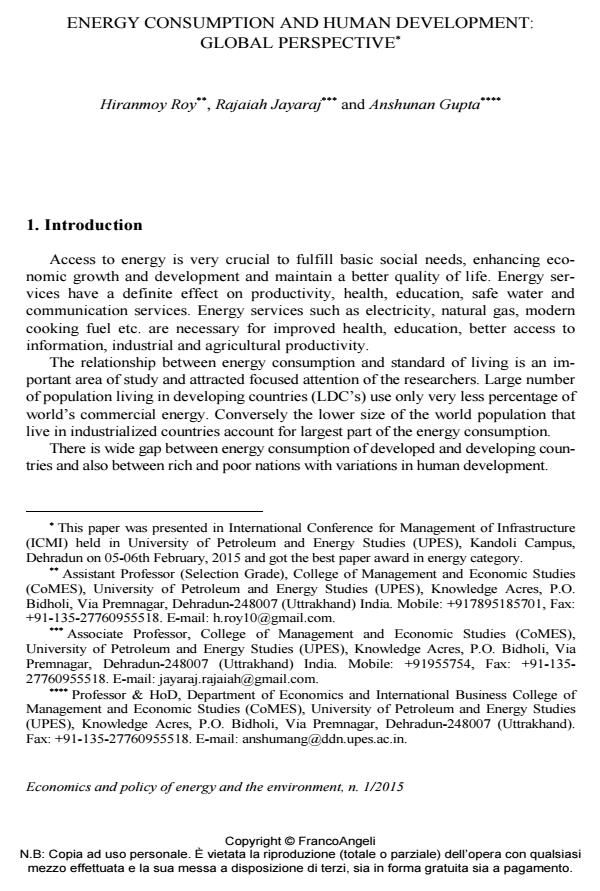Energy consumption and human development: global perspective
Journal title ECONOMICS AND POLICY OF ENERGY AND THE ENVIRONMENT
Author/s Hiranmoy Roy, Rajaiah Jayaraj, Anshunan Gupta
Publishing Year 2016 Issue 2015/1
Language English Pages 21 P. 111-131 File size 488 KB
DOI 10.3280/EFE2015-001008
DOI is like a bar code for intellectual property: to have more infomation
click here
Below, you can see the article first page
If you want to buy this article in PDF format, you can do it, following the instructions to buy download credits

FrancoAngeli is member of Publishers International Linking Association, Inc (PILA), a not-for-profit association which run the CrossRef service enabling links to and from online scholarly content.
The important objective of this paper is to study the long run relationship between Energy Consumption (EC) and traditional Human Development Index (tHDI) and impact of Energy Consumption on tradional Human Development Index. The scope of this study is that the energy consumption has a great role to play in enhancing economic growth and maintaining better quality of life and overall human development. The authors have used panel cointegration test to study the long term relationship between traditional Human Development Index and Energy Consumption. To study the impact of Energy Consumption on traditional Human Development Index, panel regression is used. Findings have confirmed the existence of the long run relationship between each other and the Energy Consumption has a significantly positive impact on traditional Human Development Index. To see how EC affects and change HDI an alternative New HDI is also introduced by incorporating energy consumption along with existing indices included in tHDI. After incorporating the energy component in New HDI, most of the countries HDI value slipped except few developed countries.
Keywords: Human development, energy consumption, panel data
Jel codes: P28, Q43, O15
- Energy, Environment and Globalization Hiranmoy Roy, Narendra N. Dalei, pp.127 (ISBN:978-981-13-9309-9)
- The Role of Energy Consumption and Economic Growth on Human Development in Emerging (E-7) Countries: Fresh Evidence from Second-Generation Panel Data Analyses Oktay Kizilkaya, Oktay Kizilkaya, Gökhan Akar, Faruk Mike, in Problemy Ekorozwoju /2024 pp.186
DOI: 10.35784/preko.5798 - GHG Emissions and Fossil Energy Use as Consequences of Efforts of Improving Human Well-being in Africa Late' Lawson-Lartego, in SSRN Electronic Journal /2020
DOI: 10.2139/ssrn.3596978
Hiranmoy Roy, Rajaiah Jayaraj, Anshunan Gupta, Energy consumption and human development: global perspective in "ECONOMICS AND POLICY OF ENERGY AND THE ENVIRONMENT" 1/2015, pp 111-131, DOI: 10.3280/EFE2015-001008